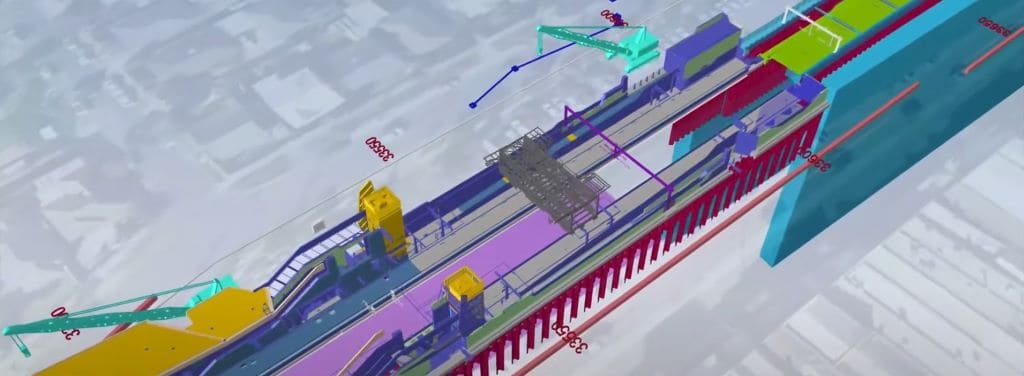Today’s construction landscape is being greatly impacted by skilled labor shortages and the rising cost of materials, all chipping away at profit margins. Digital tools are helping to offset this impact by improving productivity and controlling costs to help companies remain competitive amid a backdrop of surging infrastructure investment. A Common Data Environment (CDE) is a relatively simple tool that can improve information management and, in turn, help companies to effectively keep up with current demand. However, many companies struggle with implementing a CDE, and often justify the lack of investment, to the lack of a clear return on investment. So, is a Common Data Environment worth the investment?
In response to the lack of tangible ROI evidence, the Centre for Digitally Built Britain (CDBB) concluded in their Value of Information Management in the Construction and Infrastructure Sector report that the use of Information Management could potentially secure between GBP 5-6 of direct labor productivity gains for every GBP 1 invested, and approximately GBP 7 in direct cost savings (from reductions in delivery time, labor time and materials) as well as further benefits across the whole asset lifecycle. There is also the wider social and environmental value to consider from delivering high-quality builds with less construction blight in neighboring areas and reduced carbon emissions due to more sustainable assets.
What is a Common Data Environment (CDE)?
The common data environment (CDE) is a central cloud-based digital repository where construction project and asset information is collated, managed, and stored. Information could include documents, graphical models, and non-graphical assets. A CDE is often referred to as the ‘single source of truth’ as it should be the single definite place for project information, encouraging project teams to collaborate and share information in a structured and consistent manner rather than via emails, or generic document sharing systems.
A CDE should facilitate the principles of the BIM (Building Information Modelling) framework which is to ensure that appropriate information is created in a suitable format at the right time so that better decisions can be made throughout the design, construction, and operation of a built asset. Although there is a common misconception that BIM is just about technology, BIM is a collaborative process, and as such more about the people and processes they follow, than the technology itself.
Challenges of Information Management
With increasing client demand for sustainable assets, good information management across the project delivery stages is critical in order to leverage data and analytics across the asset lifecycle, increasingly through a digital twin, and ensuring optimized return on investment.
One of the main challenges of project delivery is the management and control of information such as documents, drawings and data, across the supply chain. Whilst there are many ‘free’ solutions for sharing information, such as email or use of generic file-sharing solutions such as Dropbox, these often result in loss of information due to staff turnover, leading to construction delays or worse, rebuilds, severely impacting margins as well as your reputation.
There are also hidden costs – the costs of on-premise file servers and additional network storage for all those large, data-rich models that may need to be retained can put a strain on IT budgets. Time costs of searching across multiple systems and silos every day to answer simple project queries or locate the last survey should also be considered.
Additionally, carbon emissions come into play when considering hidden costs associated with information management. By preventing the need for sending and storing multiple versions of the same file, businesses benefit from reduced data center usage, and in turn lower electricity use. Information management consultants Amodal estimated the carbon savings that their customer British Land could generate by not having to email contributors copies of all information about a project component could reach 153 kilograms per person.
During the design and construction stages, whether considering how best to meet these increased demands, or planning on embracing drones or augmented and virtual reality to meet engineering challenges, it’s imperative that all companies in the supply chain get on board with standards so data can be shared in a useful and productive manner.
 A common data environment ensures information standards are maintained across the whole supply chain, improving project delivery.
A common data environment ensures information standards are maintained across the whole supply chain, improving project delivery.Comply with Industry Standards
At the heart of this are information management standards such as ISO 19650, which support the principle foundations of BIM (Building Information Modelling) adoption. Many in the supply chain still haven’t grasped the benefits of the standards, as companies see them as extra administrative burdens to already time-consuming processes.
Take the following scenario as an example. On a typical GBP 50-100m construction project, thousands of documents and drawings can be produced. The trouble is that information is often unstructured, poorly coordinated and difficult to find, especially if they use spreadsheets, DropBox, and other generic systems. It has been estimated that we use only 4% of the project information we generate but we spend more than half a day every week trying to find it. It’s no wonder that 20% of larger projects overrun when finding information causes such as obstructions to progress.
To combat this, digital, structured systems must be employed across all tiers of the supply chain, regardless of how much individual projects are worth. As the CDBB report demonstrates, well-structured information management systems improve business operation, assure compliance, and improve productivity.
Common data environments (CDE) such as BCDE from Bentley can help make this a reality as they can enforce document naming conventions, to ensure documents are named in a consistent manner, and information is managed using ISO 19650 workflows such as WIP, Shared, Published and Archived. Information structured in this manner can also be transferred between systems far more efficiently, so for instance, once designs have been reviewed and approved in a system such as Bentley’s ProjectWise, they can be transferred to the project delivery CDE such as BCDE, and at handover the final approved information shared to the client’s asset information management system.
Information presented and managed in the correct structures and formats streamlines the project delivery process; establishing control, quality and visibility. With quality control and compliance never more important than it is now, the construction industry has to be proficient in the way data is structured, to ensure both happy clients and a thriving industry.
Create Digital Twins using CDE
A CDE provides a collaborative environment that encourages teams to work together, following a formal and standardized approach to managing project information, reducing the risk of mistakes, and controlling costs.
Comprehensive, structured solutions such as a Common Data Environment (CDE) guarantee information is stored all in one place, assuring traceability of information, accountability, and collaboration.
Not only does a CDE create a shared language for everyone to use across a project, it’s also the foundation for digital twins and systems interoperability which are increasingly requested by clients looking to optimize their data and increase asset performance, compliance and resilience. Your client may be requiring you to transfer information from your Project Information Modelling (PIM) CDE into their Asset Information Management (AIM) CDE at handover so structured data is key to a streamlined process.
Begin With a Digital Strategy
 Any digital information management should not be seen in isolation, but as part of your future digital strategy.
Any digital information management should not be seen in isolation, but as part of your future digital strategy.So how do companies take advantage of CDEs proven benefits and select the right CDE?
When selecting a CDE, it’s essential to find a solution that will fit into the overall organizational strategy as well as into any ongoing digital strategy. An understanding of the CDE’s intended purpose is crucial – ask how it will be used in the long term:
- Across multiple departments, project teams or across different companies?
- For the design and build stages only, or after handover?
- Or, as the basis for a digital twin of a physical asset?
One of the recommended routes, even for large companies, is to identify a pilot project. This could be a joint venture project, or used to improve processes internally.
During his webinar about the digital transformation of NHS Scotland (NHSS), one of the largest asset owners in the UK with over 2,000 built assets such as acute hospitals and doctors surgeries, David Philp, AECOM, director for digital consulting strategy and innovation, explains ‘One of the things that NHSS undertook right at the very beginning it was a proof of concept that the common data environment (CDE) would improve decision making, and involved a series of key tests such as the ability to transfer information accurately, to undertake audit trails of documents, ease of access to information and view models and drawings too, but also to check functionality, especially with older systems and the ability to link with other NHS systems.’
Taking the first steps in this manner is achievable for any company. Invest in a solution that supports all project information management and collaboration needs and is intuitive for users. Doing this ensures project teams become confident in the use of a single system, knowledge is recycled and clients build trust in your digital delivery abilities. Choose a solution that will flex with your needs, and enable you to expand as your digital capabilities or requirements grow.
As with any major change, the drivers have to come from internal business goals and be fully supported by the leadership team. Digital Information management should not be seen in isolation, but be part of your future digital strategy.
As David further explains, ‘NHSS underwent rigorous testing not only in terms of functionality but also how the CDE would support the business objectives and priorities such as Value and Sustainability, Safety, and Effective Quality of Care.’
Equal time and funding should be invested in people, processes, and technology to deliver success and to ensure an organization is not only fit to survive but fully competitive for the future.







